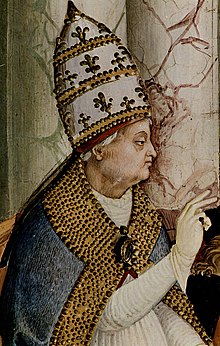Pope Pius II
|
Pope Pius II |
|
|---|---|
| Bishop of Rome | |
 |
|
| Papacy began | 19 August 1458 |
| Papacy ended | 14 August 1464 |
| Predecessor | Callixtus III |
| Successor | Paul II |
| Orders | |
| Ordination | 4 March 1447 |
| Consecration | 15 August 1447 by Juan Carvajal |
| Created Cardinal | 17 December 1456 by Callixtus III |
| Personal details | |
| Birth name | Enea Silvio Bartolomeo Piccolomini |
| Born |
18 October 1405 Corsignano, Republic of Siena |
| Died | 14 August 1464 (aged 58) Ancona, Marche, Papal States |
|
Papal styles of Pope Pius II |
|
|---|---|
 |
|
| Reference style | His Holiness |
| Spoken style | Your Holiness |
| Religious style | Holy Father |
Pope Pius II (Latin: Pius PP. II, Italian: Pio II), born Enea Silvio Bartolomeo Piccolomini (Latin Aeneas Silvius Bartholomeus; 18 October 1405 – 14 August 1464) was Pope from 19 August 1458 to his death in 1464. He was born at Corsignano in the Sienese territory of a noble but impoverished family. His longest and most enduring work is the story of his life, the Commentaries, which is the only autobiography ever written by a reigning pope.
Aeneas was born to Silvio, a soldier and member of the House of Piccolomini, and Vittoria Forteguerri, who had 18 children including several twins, though most died at a young age.He worked with his father in the fields for some years and at age 18 left to study at the universities of Siena and Florence. He settled in the former city as a teacher, but in 1431 accepted the post of secretary to Domenico Capranica, bishop of Fermo, then on his way to the Council of Basel (1431–39). Capranica was protesting against the new Pope Eugene IV's refusal of a cardinalate for him, which had been designated by Pope Martin V. Arriving at Basel after enduring a stormy voyage to Genoa and then a trip across the Alps, he successively served Capranica, who ran short of money, and then other masters.
In 1435 he was sent by Cardinal Albergati, Eugenius IV's legate at the council, on a secret mission to Scotland, the object of which is variously related even by himself. He visited England as well as Scotland, underwent many perils and vicissitudes in both countries, and left an account of each. The journey to Scotland proved so tempestuous that Piccolomini swore that he would walk barefoot to the nearest shrine of Our Lady from their landing port. This proved to be Dunbar; the nearest shrine was 10 miles distant at Whitekirk. The journey through the ice and snow left Aeneas afflicted with pain in his legs for the rest of his life. Only when he arrived at Newcastle, he felt he had returned to "a civilised part of the world and the inhabitable face of the Earth", Scotland and the far north of England being "wild, bare and never visited by the sun in winter". In Scotland, he fathered a child but it died.
...
Wikipedia
